NARBO
Roadmaps for River Basin Investments
by Dennis Von C. Custodio
IWRM Specialist and RETA 6470 Coordinator (Consultant)
Asian Development Bank
![]()
1. Background
NARBO’s goal is to help achieve integrated water resources management (IWRM) in river basins throughout Asia. It aims to strengthen the capacity of river basin organizations (RBOs) in promoting IWRM and improving water governance.
Roadmaps for river basin investments can help to achieve IWRM.
Investments for IWRM
IWRM is a long-term process that seeks to realize investments in water resources development and management that have “triple bottom line” (i.e. economic, social, and environmental) benefits resulting from an integrated approach.
Such investments can be facilitated, encouraged and realized through the river basin roadmaps.
The roadmaps can serve as basis for future project preparatory technical assistance for subsequent implementation of one or several projects on IWRM. They can sort out gaps and overlaps in basin investments, and can provide guidance on implementation.
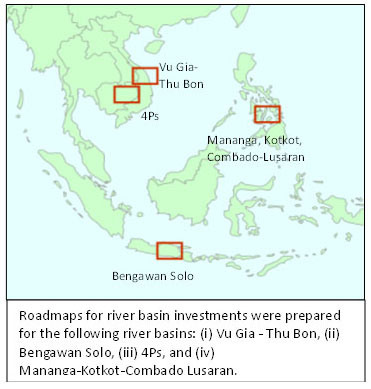
Modality to Prepare the Roadmaps
Under the ADB-supported regional technical assistance project on ‘Managing Water in Asia’s River Basins: Charting Progress and Facilitating Investments’, river basin investment roadmaps were prepared from 2009 to 2011 for the following strategic river basins:
(i) 4Ps in Cambodia,
(ii) Vu Gia – Thu Bon (VGTB) in Viet Nam,
(iii) Solo in Indonesia, and
(iv) Mananga-Kotkot-Combado Lusaran (MKCL) in Philippines.
The project, approved in 2008, aims to encourage further basin water investments under ADB’s Water Financing Program. It is hosted by the Center for River Basin Organization and Management (CRBOM)*1
which is one of the four organizations comprising the NARBO Secretariat, and which is based in the Solo river basin in Java island in Indonesia.
*1The CRBOM is also the regional water knowledge hub on river basin organization and management under the Asia Pacific Water Forum.
![]()
2. What is a roadmap for river basin investments?
A basin development agenda for IWRM
A roadmap for river basin investments reflects a specific development agenda for the river basin. The agenda adopts the river basin as planning unit and applies an IWRM perspective that emphasizes holistic, integrated, cross-sectoral, coordinative, multi-disciplinary, and participatory approaches that are in accordance with national development policies, plans, and priorities.
An action plan
A roadmap for river basin investments is a concise action plan on proposed water-related investments and development initiatives. The action plan answers the questions ‘what to do’, ‘who will do’, and ‘when to do’. The basin investments may include short-term, medium-term, and long-term development projects. They can cover hard and soft measures including infrastructural development (both structural as well as non-structural), irrigation management, tourism development, water-dependent production, capacity-development and knowledge-building, institutional development, and others.
A direction or road
|
|
Who Prepares and Implements
|
|
|
|
If there is no RBO, creating one may be considered as a component development initiative of the roadmap. Implementation of the roadmap can be facilitated by the RBO, but the development initiatives and investment projects may be implemented by sector or line agencies. |
|
![]()
3. Preparing the roadmap for river basin investments*2
Basin Stakeholder Consultation: A Critical Component in Preparing Roadmaps
IWRM is a long-term process that needs sustained commitment by all stakeholders. The active and informed participation of stakeholders in the planning and decision-making for integrated investment programs is central to IWRM’s success. In order to successfully prepare the roadmaps, the conduct of a series of basin stakeholder consultation workshops is necessary. These workshops provide guidance and elicit a sense of acceptance, ownership, and commitment from the stakeholders. The consultation process facilitates inter-agency dialogue as well as institutional coordination and synergies.
Roadmap Advisory Service: Sharing Lessons and Experience from Other River Basins
NARBO aims to strengthen the capacity of RBOs through the exchange of information and experience among RBOs and their associated water sector agencies. Along this line, a roadmap advisory service was offered under the project and was piloted in preparing the investment roadmaps for four river basins. The service allowed peer advisers from other river basins in the region to share lessons and experience on (i) keys for success in implementing IWRM, (ii) roadmap preparation, (iii) basin development scenarios, and (iii) project implementation modalities and technicalities. It allowed close dialogue with basin stakeholders to explore common solution strategies to IWRM challenges; and added value to the overall learning process.
Steps to Prepare the Roadmaps
Within the context of the project, the following steps were undertaken to prepare the roadmaps:
-
Gathering data and information. This includes preparing or updating a ‘basin profile’ on the basin’s natural and socio-economic characteristics; identifying the basin stakeholders and strategizing on how to liaise with them; reviewing literature including an overview of existing documents and information sources, the national socio-economic planning framework, the role of the RBO (if any) in the river basin, and development opportunities and initiatives, among others.
-
Drafting a roadmap framework. This includes identifying the preliminary vision, goals, and development initiatives. It also includes preparing a small activity list on what to do and who does what.
-
Conducting the 1st basin stakeholder consultation workshop. This involves consultation with and participation by stakeholders for their inputs and guidance; and sharing of experiences by regional RBO peer advisers from other river basins.
-
Preparing the first draft of the investment roadmap. This involves adjusting the draft roadmap framework and incorporating the guidance received from the 1st workshop.
-
Conducting 2nd basin stakeholder consultation workshop. This reviews, and revises as necessary, the 1st draft roadmap; and again involves basin stakeholders and the regional RBO peer advisers to validate the roadmap’s adequacy and implementation prospects.
-
Finalizing the roadmap for printing and publication. This includes sequencing of identified development initiatives; and packaging the roadmap for printing, publication and dissemination.
The roadmap is revised regularly to reflect new challenges, new opportunities, and new knowledge.
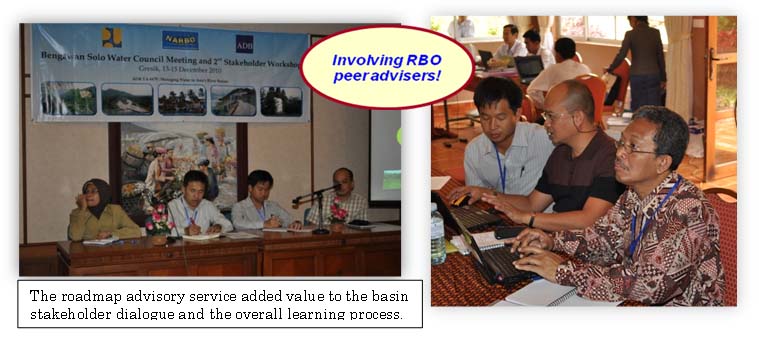
A highlight of the whole exercise was the mutual sharing of experiences and lessons by both the basin stakeholders and the regional peer advisers that resulted to the successful preparation of the investment roadmaps in the four river basins.
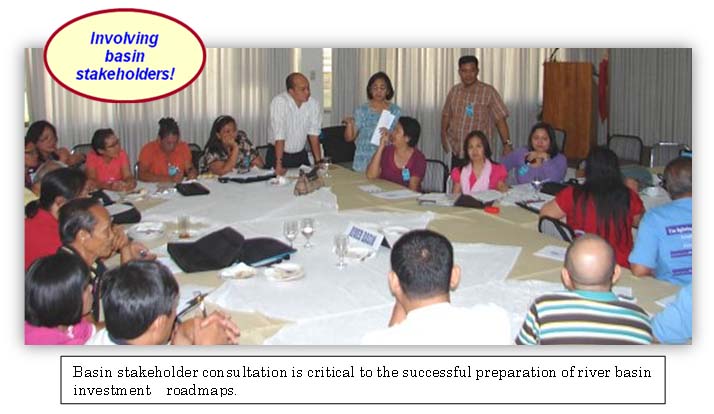
*2 Source: ADB. CRBOM. Guideline for IWRM-based Investment Roadmaps. January 2012
![]()
4. Roadmaps for investments in four river basins
The following paragraphs briefly describe the river basin and summary of the investment roadmaps.
(i) 4Ps river basin
The 4Ps river basin is located in the northeastern part of Cambodia; and situated to the east of the Tonle Sap and the Mekong River. It is formed by the drainage basins of four preks (small rivers) that discharge into the Mekong River: Prek Preah, Prek Krieng, Prek Kampi and Prek Te. It covers the provinces of Kratie and Mondulkiri, with an area of around 12,470 km2 and an estimated population of only 163,000 as of 2010. The basin is among the least developed in Cambodia. Water-related infrastructure is limited, and the few existing ones were built during the Pol Pot regime. The poverty rate is among the highest in the country; and most of the population are subsistence farmers. The socio-economic conditions change with distance from the Mekong River. Near the Mekong, the population density is higher, and the economy is better developed and more diversified as compared with the inland parts of the river basin.
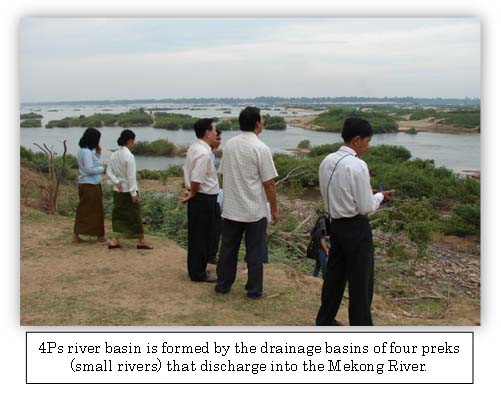
The 4Ps river basin investment roadmap*3 was prepared by Cambodia National Mekong Committee in collaboration with the provinces of Kratie and Mondulkiri.
Vision
The vision for the 4Ps river basin is: ‘A healthy river basin with integrated sustainable development plans implemented jointly by the people and the government primarily for the benefit of the 4Ps people.’
Goals
The goals to achieve this vision are: (i) improved water security, (ii) economic development, livelihoods and social welfare, and (iii) a healthy river basin.
Development Initiatives
Some development initiatives to achieve these goals are: (i) water supplies and services, (ii) integrated agricultural development, and (iii) environment protection and management.
*3 ADB RETA 6470. The 4Ps Area, Cambodia - Investment Roadmap for Water-related Development. September 2010
(ii) VGTB river basin
The VGTB river basin is located at the central part of Viet Nam. It is formed by two main rivers: The Vu Gia and the Thu Bon. It covers parts of Danang City, Quang Nam Province, and Kon Tum municipality with an area of around 10,350 km2 (the 9th largest in Viet Nam) and an estimated population of 1,900,000 as of 2011. Compared to 4Ps, it has a smaller area but has a larger population. Similar to many other river basins in Asia, it is also beset by problems in water resources management, including: floods and drought, deforestation, groundwater depletion, salinity intrusion, and biodiversity degradation. It is home to the historic old town of Hoi-An -- which is a prime tourist destination and a UNESCO World Heritage Site as an example of a well-preserved trading port since the 15th century.
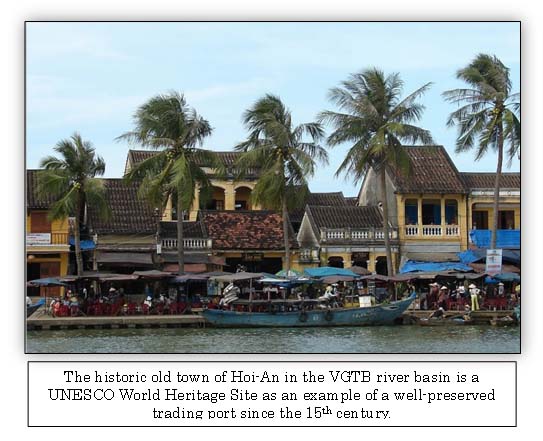
The VGTB river basin investment roadmap*4 was prepared by the Department of Natural Resources and Environment, in collaboration with Danang City and Quang Nam Province.
Vision
The vision for the VGTB river basin is: ‘A healthy river basin, prospering from its rich resources, with access to water for those who need it for households, livelihoods and production, and protection against floods and drought.’
Goals
The goals to achieve this vision are: (i) basin-level management arrangements, (ii) water security, and (iii) a healthy river basin.
Development Initiatives
Some development initiatives to achieve these goals are: (i) creation of a Vu Gia-Thu Bon RBO, (ii) flood and drought management, and (iii) water quality, aquatic habitats, and wastewater management.
*4 ADB RETA 6470. Vu Gia-Thu Bon River Basin, Viet Nam - Investment Roadmap for Water-related Development (Draft). December 2011
(iii) Solo river basin
The Solo river basin is located in the central-eastern part of Java island. It covers the provinces of Central Java and East Java with an area of 16,100 km2 and a population of around 16 million as of 2010. Agriculture is the largest economic sector in the basin.
The river basin is flood-prone, and major floods occur regularly. Drought is also frequent, affecting both the rain-fed and the irrigated areas. Parts of the basin are exposed to erosion which causes damage to the infrastructure, increases siltation in the reservoirs (notably the Wonogiri Reservoir), and adds to flood risk. Degradation of the watershed causes erosion and results in massive sedimentation in the Wonogiri Dam reservoir and in the upper and middle reaches of the river. Some parts of the basin suffer from deforestation and deterioration of water quality.
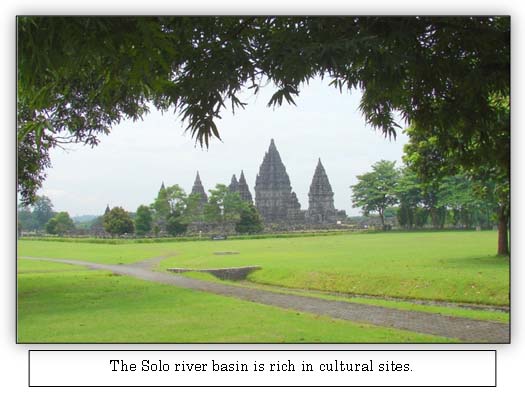
The Solo basin investment roadmap*5 was prepared by Bengawan Solo Basin Council and was approved by the Ministry of Public Works of Indonesia in March 2010.
Vision
The vision for the Solo river basin is: ‘Right and proper public works infrastructure services in water resources in the basin of Bengawan Solo for maintaining water resources conservation, and a productive and sustainable life for people who live in the Bengawan Solo Basin.’
Goals
The goals to achieve this vision are: (i) water resources conservation, (ii) water resources utilization, (iii) water destructive force control, (iv) availability of water resources data and information, and (v) public empowerment and participation.
Development Initiatives
Some development initiatives to achieve these goals are: (i) protection and conservation of water resources, (ii) development and provision of water resources, (iii) recovery and rehabilitation, (iv) information management system, and (v) modalities for public participation.
*5 ADB RETA 6470. Bengawan Solo Basin, Indonesia - Strategic Development Plan (Pola) for Water-related Development. Unofficial English Translation. January 2011
(iV) MKCL river basin
The MKCL river basin is located in the central part of Cebu island in Philippines. It is a cluster of 3 small river basins: Mananga, Kotkot and Combado Lusaran having a combined area of 525 km2 and a population of around 216,048 as of 2010. The basin serves as the primary water resource of Central Cebu. It is mountainous with farming as a major occupation. About 2/3 of the population live below the poverty line. The downstream is polluted due to ineffective implementation of solid waste management programs, excessive quarrying of sand and gravel, and the uncontrolled pollution by encroaching informal settlements.
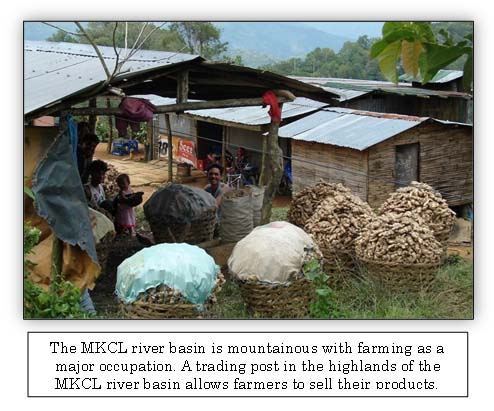
The MKCL river basin investment roadmap is a composite roadmap*6 consisting of separate roadmaps for each of the three river basins. From the three roadmaps, a generic roadmap was prepared which retains three separate visions for each of the river basins but reflects the common goals and development initiatives.
Visions
‘A healthy river basin with general access to water, sanitation and electricity; adequate and sustainable livelihoods; and protection against human and natural threats to the environment enjoyed and managed by an empowered community of stakeholders’ (Mananga river basin)
‘Sustainable, safe and accessible water supply through integrated water resources management’ (Kotkot river basin)
‘Combado Lusaran, full of trees and other natural resources and clean water that provide for the holistic needs of its communities towards sustainable socio-economic and environmental development’ (Combado Lusaran)
Goals
The goals to achieve these vision are: (i) improved water security, (ii) socio-economic development including livelihoods, and (iii) healthy rivers and habitats.
*6 ADB RETA 6470. Mananga, Kotkot and Combado Lusaran River Basins, Central Cebu, Philippines - Investment Roadmaps for Water-related Development. September 2010
Development Initiatives
Some of the development initiatives to achieve these goals are: (i) safe water and sanitation, (ii) tourism development, and (iii) disaster risk reduction.
Table 1 Summary of Investment Roadmaps in the Four River Basins
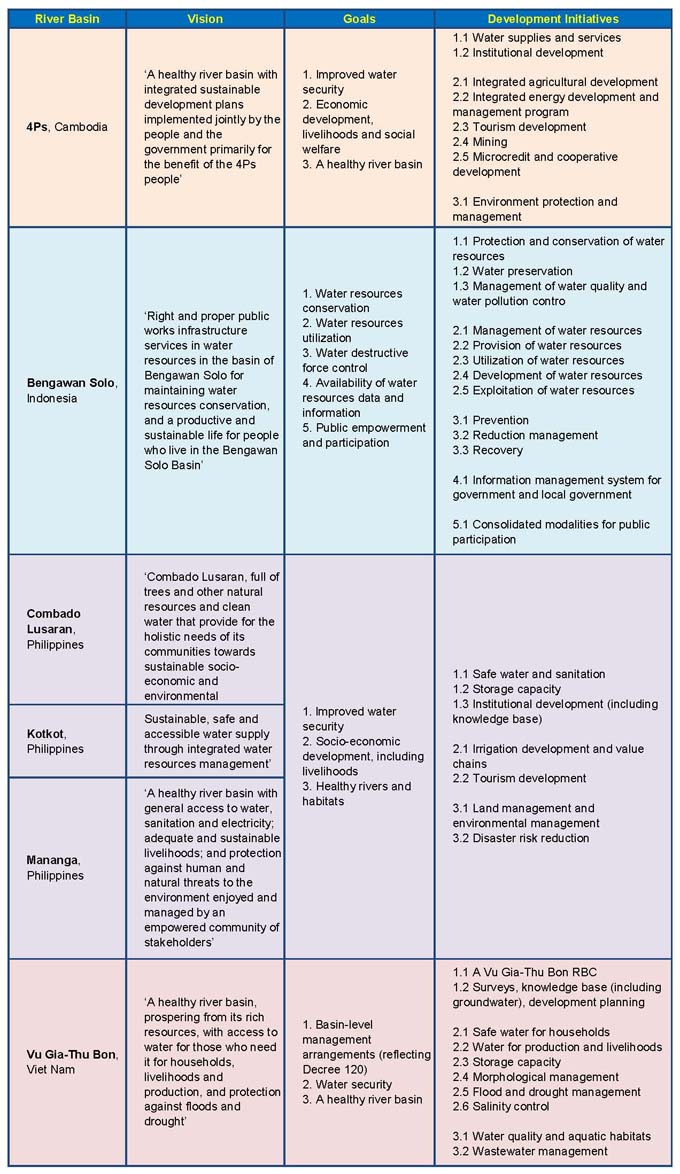
The four study river basins are rich, diverse, and unique.
Each offers a variety of livelihoods, abundant natural resources, unique habitats, and an attractive scope for development.
The vision of each river basin is different from the others. For example, ‘integrated sustainable development plans’ is unique for the 4Ps vision; the need for ‘infrastructure services’ is unique for Solo vision; ‘sustainable socio-economic and environmental development’ is unique for the Combado Lusaran vision; ‘IWRM is unique for the Kotkot vision. ‘Empowered community of stakeholders’ is unique for the Mananga vision; and ‘protection against floods and drought’ is unique for the VGTB vision.
The difference in the visions, and to a certain extent to the development initiatives, is not surprising considering the varying degrees of development, and different sets of resources, needs, priorities, challenges, and development agenda in each basin. Policies, legislation and management frameworks also vary from one basin to another.
The proposed development initiatives and investment projects are wide-ranging, and consist of both hard and soft measures as well short-term and long-term projects.
For any queries, please contact Mr. Dennis Von C. Custodio, dvcustodio.consultant@adb.org.

